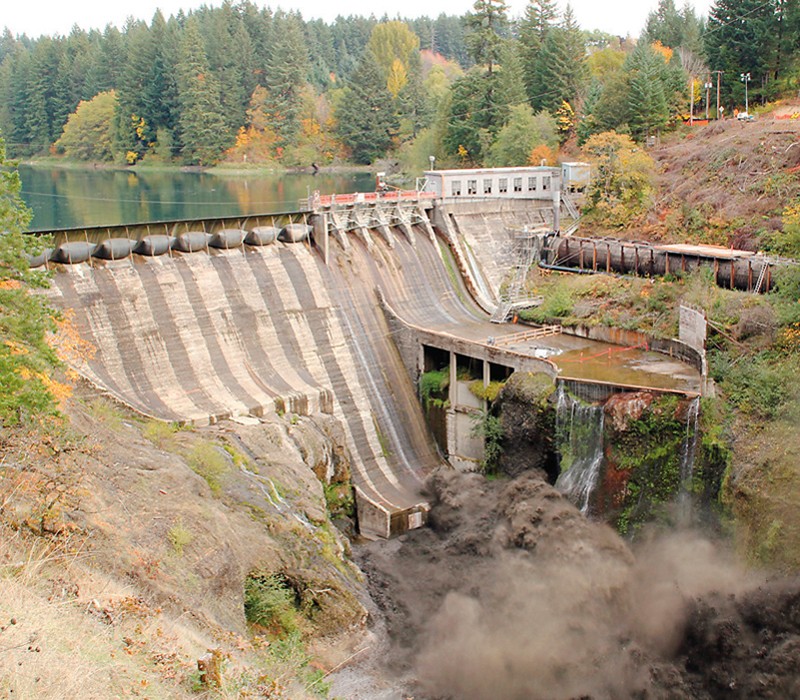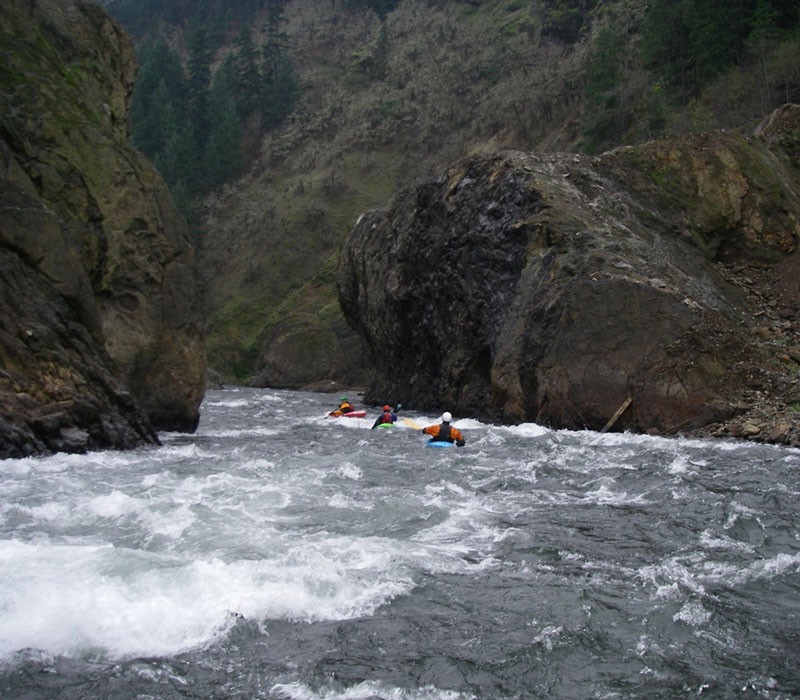Videos and links
Legacy Film - Condit: There was a dam here
Condit Legacy Film: There was a dam here
Condit Dam final blast
Watch the final moments leading up to the 12:11 p.m. blast of the Condit Dam tunnel.
Another view of the reservoir draining using timelapse.
Video of breach includes sound. Video by Andy Maser Films. Andy Maser and Steve Stampfli.
White Salmon Restored: A Timelapse Project
White Salmon Restored: A Timelapse Project
Website by Andy Maser and Steve Stampfli uses timelapse photography to document the deconstruction of Condit Dam and the river restoration to follow.
University of Montana Timelapse of Reservoir
University of Montana Geomorphology Lab
Video 1 - Timelapse photography of draining of Northwestern Lake and reservoir erosion
Video 2 - Timelapse photography of draining of Northwestern Lake and reservoir erosion
Overview
PacifiCorp owns and operates the Condit Hydroelectric Project, which was completed in 1913 on the White Salmon River in Skamania County and Klickitat County, Washington. The project is regulated by the Federal Energy Regulatory Commission (FERC) as project number 2342. The project is located approximately 3.3-miles upstream from the confluence of the White Salmon and Columbia Rivers. Project facilities consist of a 125-foot high, 471-foot long concrete gravity diversion dam, an intake structure that directs water into a 13.5-foot diameter by 5,100-foot long wood stave flowline, and through a 40-foot diameter concrete surge tank. The flowline bifurcates inside the surge tank into two 9-foot diameter penstocks that supply water to the powerhouse. The powerhouse contains two double horizontal Francis turbines with an installed capacity of 14,700 kilowatts. The project creates a reservoir, Northwestern Lake, which extends 1.8-miles upstream of the dam and covers approximately 92 acres.
PacifiCorp has regulatory approvals to remove the project in accordance with the amended Condit Settlement Agreement and the Project Removal Design Report. Regulatory approvals include Clean Water Act permits issued under Section 401 by the Washington Department of Ecology, and issued under Section 404 by the U.S. Army Corps of Engineers, and a Surrender Order from the Federal Energy Regulatory Commission. The method for dam removal involves clearing sediment and debris immediately upstream from the tunnel and then drilling and blasting a 13-foot by 18-foot drain tunnel in the base of the dam to within a few feet of the dam’s face. During the month of October, sediment and debris immediately upstream from the dam will be cleared to form a pathway and then the remainder of the tunnel will be blasted to drain the reservoir and flush impounded sediments out of the reservoir as rapidly as possible. Following the final tunnel blast, the drain tunnel will discharge at a rate of about 10,000 cubic feet-per-second – approximately 25 percent of the estimated peak discharge during the February 1996 flood event on the White Salmon River. This will drain the reservoir in approximately six hours. Rapid draining of the reservoir is expected to mobilize much of the estimated 2.4-million cubic yards of sediment that has accumulated behind the dam since its construction. Previous modeling has indicated that between 1.6 million to 2.2-million cubic yards of sediment will be discharged into the White Salmon River immediately following dam removal.
Once the reservoir is drained, activities will focus on addressing the sediment and slope stability within the former reservoir area. In the spring of 2012, the dam will be excavated and removed along with the flowline, surge tank, and penstocks. Concrete from the dam will be buried onsite; other materials will be salvaged or transported to the Klickitat County waste facility. The powerhouse will be left intact. The upstream cofferdam in the White Salmon River present from original dam construction will be removed from the river as soon as practicable after the breach. PacifiCorp Energy expects to complete the dam removal process within one year, start to finish. Subsequently, restoration of the former reservoir areas may take an additional year or more.
Removal of Condit dam is expected to provide the following benefits:
- Anadromous salmonids will be provided access of up to 18 miles of White Salmon River mainstem and tributary habitats that have been inaccessible since the early 1990s. Restoration of natural runs of anadromous fish upstream of the project dam is consistent with the fishery management goals of the National Marine Fisheries Service, U.S. Fish and Wildlife Service, Washington Department of Fish and Wildlife, and the Yakama Nation.
- Dam removal offers the greatest potential for full utilization of anadromous fish habitat, including habitat inundated by Northwestern Lake, and therefore, full restoration of anadromous salmonids within the White Salmon River basin.
- Dam removal will benefit wildlife dependent upon anadromous fish in the area of the river reach upstream of river mile (RM) 3.3.
- Dam removal will provide increased whitewater recreation opportunities. Whitewater recreation is an important and popular use of the White Salmon River.

